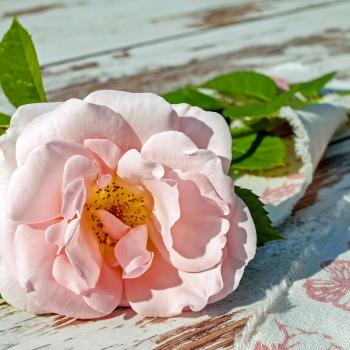Even though I was not technically required to, I only wore skirts. Even though my mother had good fashion sense and enjoyed buying a new dress, I wore baggy homemade dresses or oversized T-shirts with shapeless skirts (much to her consternation, I think). Why? Because doing so made me feel oh so much holier and more virtuous than everyone else.
I’ve written before about how my friends and I drove each other to be more extreme in our desire to be as godly as we could possibly be. Well, the same was true for clothing. There was a sort of peer pressure to dress more modestly. It’s funny because my parents and so many other parents spoke of homeschooling in an effort to keep us away from peer pressure. What they didn’t realize is that peer pressure didn’t disappear; instead, we just face pressure from a different group of peers.
If you went to a (Christian) homeschool gathering dressed less “modestly” than anyone else there, you would stick out. You would appear different. You might have people whispering about you. You might well feel self-conscious. Dressing modestly was a way to fit in, and dressing especially modest was a way to send the signal that you were especially godly. Because, you know, you didn’t dress like a slut like those other girls.
A Sober Second Look recently wrote a post that outlined perfectly how modesty can become a peer pressure issue:
I remember attending the same Muslim conference several years running. The first time, I was wearing a dark green headscarf and a long, loose dark green cotton dress with yellow, blue and magenta flowers on it, over wide pants (which couldn’t be seen, as the dress reached my ankles). Modest enough, I thought, especially since it was a hot summer day. However, my attire definitely made me stand out, and not in a good way.
Every other woman was wearing a plain black head-to-toe abaya, a black chador, or a plain, dark or beige polyester headscarf with a loose, plain, dull-colored coat-dress over matching pants. The other women—many of whom were converts—stared at me. I felt like a misfit, and wondered why I had even come. Some of the other women politely tried to make conversation. A couple of them were selling scarves, coat-dresses and pants similar to what they were wearing in order to raise money for refugees from their husbands’ homeland, and encouraged me to consider buying some. But even if I had been able to afford it, none of the clothes would have fitted me.
The peak event in the conference for the women was when we had a chance to meet as a group with a senior scholar who had come from abroad, and ask him our fiqh questions. For that meeting, most of the women who had not been wearing abayas previously either put one on, or put on a chador. I had not been prepared for this, and felt really immodest by comparison. All in all, it was an alienating experience, and I was rather indignant. With the long, covering clothing I had had on, why had I been made to feel practically naked?!?
But by the time the conference the next year rolled around, I had begun to adjust my attitude. What had seemed to me as overly zealous modesty now seemed more reasonable, though I was not yet ready to think about wearing a head-to-toe abaya. I had managed to sew myself a couple of polyester scarves and coat-dresses in neutral colors, and I was wearing them on a regular basis.
When I attended the conference dressed in that way, I had a significantly different experience. Many of those coat-dress-wearing sisters who had been reserved toward me the previous year were now friendly—except for one (convert), who felt the need to draw it to my attention that when I walked briskly across the foyer, she could see my underwear lines through my coat-dress and pants. (!) (She must have been staring quite intently at my butt to notice; I wonder what was up with that.) Anyway, I politely thanked her for telling me, and walked much more slowly for the rest of the day, hoping that nothing was showing.
The next year, I was even better prepared. Over my pants and coat-dresses, I now sometimes wore a loose, wide plain robe, so I dressed like that at the conference. Nobody could possibly spot any underwear lines now. I also had started wrapping my head-scarves so that they covered all of my chest, as well as part of the lower half of my face. That was the most enjoyable conference experience yet. Partly, because my clothing was above reproach, and I fitted in as never before. Even the most austerely abaya-wearing sisters were quite friendly now.
I remember sitting with a group of sisters, several of whom were wearing plain black abayas, and the rest wearing quite conservative hijab, except for one young woman, who had on jeans, a loose shirt with three-quarter sleeves, and a thin, patterned oblong scarf that was too narrow and short to cover her head and hair completely. As two of the abaya-wearers solemnly discussed some point of Islamic belief, she sat and listened with the rest of us, her eyes downcast. She kept tugging at the cuffs of her sleeves, as if she were willing them to become long enough to cover her arms all the way to her wrists. When she wasn’t doing that, she was fidgeting with her scarf, trying to pull it a bit lower at the front of her head without uncovering more of the back.
Later, after the young woman had left, one of the abaya-wearers commented that this is the right way for Muslims to correct the mistakes of others. To not say anything to them directly in front of others, but to set them a good example, so that they would then be moved to amend their behavior accordingly, just as that young woman had been trying to adjust her clothing. Because she could see what “proper” hijab was from the other women around her.
I didn’t say anything. But what I thought at the time was that the young woman had felt really out of place. Sure, nobody said anything to her directly, but we had all noticed that her sleeves were “too short” and her scarf did not cover her head and hair completely. She had felt much the way that I had felt the first year that I had attended that conference. I wondered if she would ever want to come again.
Looking back, all this seems rather silly. We were acting like kids in high school, obsessing about what everyone else is wearing, and worrying about whether our own clothes are “cool enough”—and judging others for not measuring up to our clothing standards. Like in high school, when I can remember agonizing over the fact that although a shirt of mine was the “right” pattern and color, it had buttons, while all the cool kids’ shirts had snaps.
The funny thing is, everything A Sober Second Look describes in that excerpt from her blog, well, is something I see happening in the Christian homeschool world as well. Dressing modestly becomes about fitting in and not sticking out, and also about signalling to others in the group. And I’m afraid I fell into that trap along with the others.














